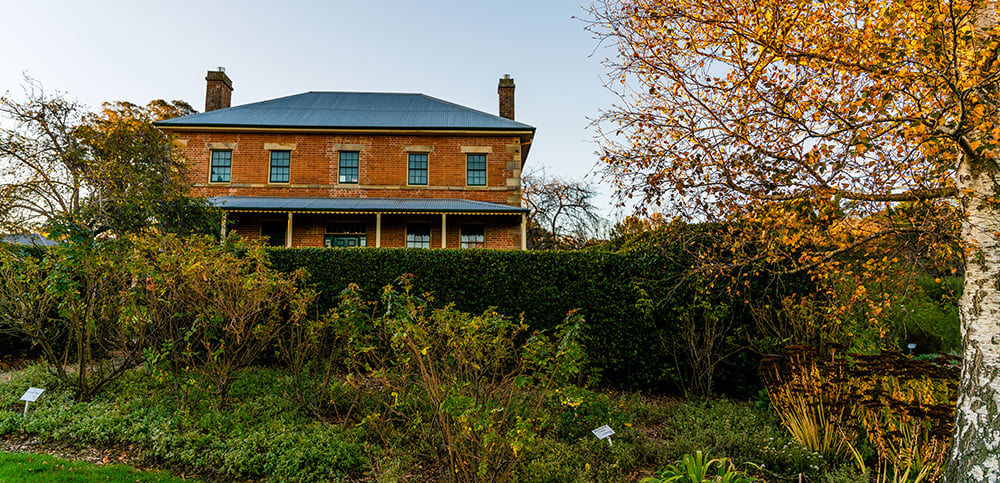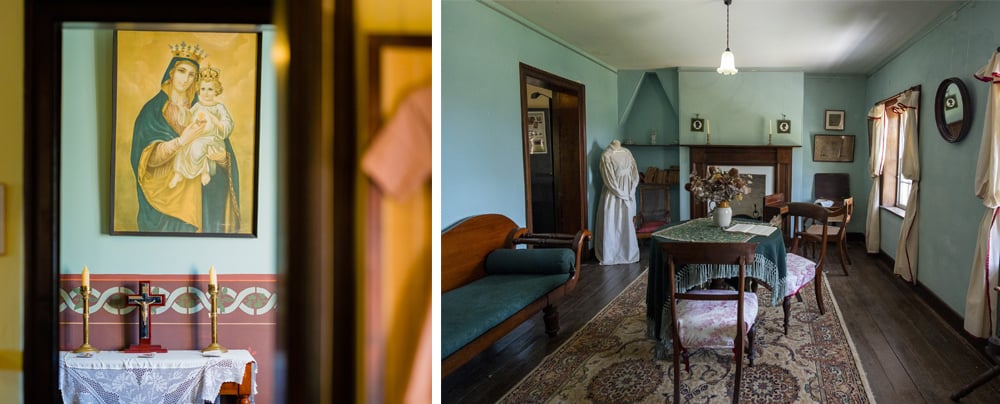Harper’s Mansion in Berrima is known for its charming Georgian architecture, heritage gardens and magnificent hedge maze. As we embark on a new appeal to restore the house and gardens, we take a closer look at its eventful history.
BY NICK CORBETT, NATIONAL TRUST GENERAL MANAGER, PROPERTIES
This article originally appeared in the April 2024 issue of the National Trust (NSW) member magazine.

The town of Berrima is on Gundungurra and Tharawal Country in the Wingecarribee region, named for its large perennial river. James Harper was among the first wave of colonial settlers to arrive in the area, helping move cattle south from Sydney in the early 1820s, before becoming Chief Constable in the Government town of Bong Bong. Unlike his illiterate parents, Harper had been educated in Parramatta, could read and write and had a keen eye for opportunity. In 1826, he married the convict Mary Robinson and the pair moved to Berrima, where they built the Surveyor General Hotel.
It was named in honour of Sir Thomas Mitchell, whose Great South Road replaced the Old South Road as the main transport route heading south. Mitchell’s new road was more suitable for transportation, avoiding the steep slopes of the Mittagong ranges. Berrima, on the Wingecarribee River, was selected as a site for a new Government town and Bong Bong soon became a ghost town.
In 1834, the Harpers purchased 100 acres overlooking Berrima for 28 pounds. Harper’s Mansion, a two-storey Georgian townhouse, was built several years later with outbuildings including a kitchen and stables. The walls were three bricks thick, all made locally at a time when labour was plentiful. While the success of the colony was built on a system that rewarded convict reform, life was hard, with only three of the seven Harper children surviving.
Harper was a heavy drinker and after mortgaging the property, found himself in financial difficulty and died in 1845. The mortgagee William Hutchinson’s death soon followed, but it appears the estate allowed Mary and her children to remain at Harper’s Mansion. Two years later, Mary married James McDermott and moved into the Surveyor General Hotel. McDermott died in 1850 and Mary six months later, at the age of 48.
Early restorations
An advertisement in The Sydney Morning Herald in 1850 provides a useful snapshot of the ‘Harper’s Hill’ house and garden, including mention of a never-failing source of water close to the kitchen. This spring has long since gone and today the property relies on one tap supplying town water.
The Catholic Church bought the property in 1853, using it as a presbytery and a home for nuns until around 1910, when it was tenanted out by the Church. The Catholic Church was prominent in Berrima – they built a church on the site of the original convict stockade and the nuns opened a school in town.

However, the construction of the Great Southern Railway in the 1860s saw two new towns emerge, Bowral and Moss Vale. Berrima had been bypassed and, like Bong Bong before it, became a backwater. It remained this way until the 1920s when the motorcar allowed for affordable, independent travel, leading to the rediscovery of this colonial-era town.
Unable to maintain the property, the Catholic Church sold it in early 1970 to Robert Cox of Berrima Estates, who divided the property into four blocks. Following pressure from the local community, who were keen to see the property saved, Mittagong Council used a Federal Government Grant to purchase Harper’s Mansion in 1978.
Ownership was transferred to the National Trust later that year. As with many early National Trust acquisitions, the primary goal was preservation.
Between 1979 and 1985 extensive restoration work was undertaken, funded by the National Trust’s Activities Committee. The building was re-roofed and external brickwork, stone and joinery were restored.
Inside, floors and ceilings were repaired or replaced and the old staircase was removed and rebuilt. The original fireplaces, windows and doors were stripped and stained.
While most of the house was returned to the 1830s period, vestiges of the Catholic occupancy remain in the dining room ceiling and corridor friezes. This work was done to the highest of standards, yet half a century later some elements, such as the stair treads, are now in need of urgent attention.
Tending the garden
While the interpretation of the house was reasonably straightforward, debate around the garden ensued for many years. The volunteers were keen to see progress, working with the National Trust to protect heritage. Esteemed heritage architect Dr Clive Lucas OBE was engaged to uncover physical evidence.
In 1984 – 138 years after the Harpers’ occupancy – Clive Lucas found “the remains of a squared cottage garden in front of the house with an axial path and evidence of a fence and gateposts”.
It wasn’t until the property was leased to landscape gardeners Michael and Sue Jackman from 1999 – 2006 that a solution was reached.
With funds to invest in the garden, the Jackmans planted a maze on the site of the original stables, bounded by a rise of catmint and lavender. Trees were planted in the lawn and curvilinear paths formed garden beds of shrubs and perennials. Unfortunately, plans to implement an irrigation system never came to fruition, something the upcoming appeal hopes to rectify.
Despite these recent changes, the garden retains a relationship to the house and echoes to the past. A kitchen garden complements the original kitchen archaeological site (pictured), with fruit trees and plants that reflect the early provenance of the house.
Elements of the 1850 garden design remain – as The Sydney Morning Herald noted at the time: “Fronting the house about an acre of land is handsomely laid out as a flower garden. In the rear is a large Kitchen Garden well stocked with choice fruit trees.” A focus of the appeal will be works to protect and interpret this archaeological site.

Today, the garden at Harper’s Mansion is a place of great harmony and beauty. The garden opens up before you like a broad meadow of shrubs and perennials. Ancient fruit trees are scattered among the garden beds, complemented by stands of heritage roses and heritage camellias. The eye is drawn to the distant eucalypts and for a moment you believe you have stepped back in time. While the illusion is broken by the occasional passing car, the tranquillity of the garden remains.
The success of the Harper’s Mansion garden relies on the dedication of its many volunteers. On a typical day up to 19 volunteers can be found working around the grounds. The property is open to the public each Saturday and Sunday, and many visitors comment that Harper’s Mansion has three key attractions: the house, the garden and the volunteers. It really is a community hub in the Southern Highlands.

The Harper’s Mansion appeal is an opportunity to allow this significant house and garden to reach its full potential, while giving back to the wonderful volunteers of Harper’s Mansion.
While the initial restoration work (1979 – 1985) focused on the house, the current appeal will focus on the garden, ensuring the sustainability of the whole property for generations to come.
A special thank you to the Harper’s Mansion Management Committee and volunteers past and present for their extensive research and care for Harper’s Mansion. Thank you also to Chris Thompson, whose research on the gardens helped inform this article, and special mention to Keith and Anthea Walker-Smith and Eric Savage for their longterm service and advocacy for Harper’s Mansion.
Please donate to save the irreplaceable
We need to raise $230,000 before 30 June, to make Harper’s Mansion sustainable for the future. New drainage and irrigation systems are required, the interiors need to be repaired and painted, and the archaeological site is in need of a cover to protect it from the elements. Show your support for the Harper’s Mansion appeal. Please donate today.

 Twitter
Twitter Facebook
Facebook Linkedin
Linkedin Email
Email